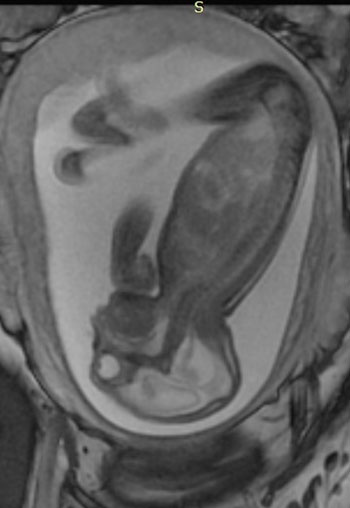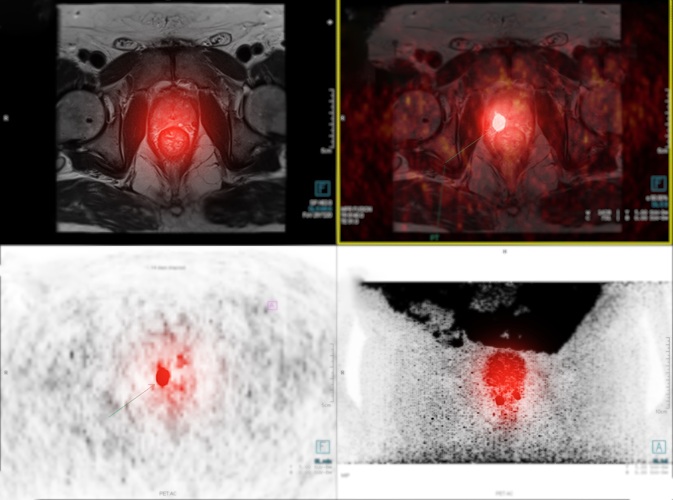Three New Studies Detail Effects of Zika Virus on Brain
|
By Andrew Deutsch Posted on 29 Nov 2016 |

Image: A side view of a fetus with hands and clubfeet, enlarged cerebral fluid space, cerebral ventricles dilation, less brain tissue, absence of brain cortical gyri, and a poorly developed cerebellum (Photo courtesy of RSNA).
The results of three new studies into the effects of the Zika virus disease in Brazil revealed multiple types of congenital brain damage.
The research was presented at the annual Radiological Society of North America (RSNA2016) meeting in Chicago, USA. One of the studies investigated Computed Tomography (CT) findings of the Central Nervous System (CNS) of 16 newborn babies that suffered from a congenital Zika virus infection. The CT brain findings showed decreased brain volume, calcifications, ventricular dilatation, simplified gyral pattern, and prominent occipital bone.
In the second study researchers analyzed scans of adults, and newborn babies with various neurological disorders, and of pregnant women with rashes indicative of a Zika infection. There were common Magnetic Resonance Imaging (MRI) findings that included enhancement of certain spinal and facial nerves. In addition, the researchers found orbital injuries and changes in the anatomy of brain tissue in the MRI scans of the newborn babies.
A third study consisted of ultrasound, and fetal MRI scans in pregnant women suffering from a Zika infection. After the babies were born, ultrasound, CT and MRI scans revealed that more than half of them had lost brain tissue volume, or suffered from microcephaly, brain calcifications and other structural changes. The researchers used 3-D virtual and physical skull models for their research.
Author of the first study, Natacha Calheiros de Lima Petribu, MD, Department of Radiology, Barão de Lucena Hospital (Recife, Brazil), said, "We live in Pernambuco, a state in northeastern Brazil, which had the highest number of patients with microcephaly during the Zika outbreak in our country. Our study proves that Zika virus infection can cause congenital brain damage in babies with and without microcephaly."
Related Links:
Barão de Lucena Hospital
The research was presented at the annual Radiological Society of North America (RSNA2016) meeting in Chicago, USA. One of the studies investigated Computed Tomography (CT) findings of the Central Nervous System (CNS) of 16 newborn babies that suffered from a congenital Zika virus infection. The CT brain findings showed decreased brain volume, calcifications, ventricular dilatation, simplified gyral pattern, and prominent occipital bone.
In the second study researchers analyzed scans of adults, and newborn babies with various neurological disorders, and of pregnant women with rashes indicative of a Zika infection. There were common Magnetic Resonance Imaging (MRI) findings that included enhancement of certain spinal and facial nerves. In addition, the researchers found orbital injuries and changes in the anatomy of brain tissue in the MRI scans of the newborn babies.
A third study consisted of ultrasound, and fetal MRI scans in pregnant women suffering from a Zika infection. After the babies were born, ultrasound, CT and MRI scans revealed that more than half of them had lost brain tissue volume, or suffered from microcephaly, brain calcifications and other structural changes. The researchers used 3-D virtual and physical skull models for their research.
Author of the first study, Natacha Calheiros de Lima Petribu, MD, Department of Radiology, Barão de Lucena Hospital (Recife, Brazil), said, "We live in Pernambuco, a state in northeastern Brazil, which had the highest number of patients with microcephaly during the Zika outbreak in our country. Our study proves that Zika virus infection can cause congenital brain damage in babies with and without microcephaly."
Related Links:
Barão de Lucena Hospital
Latest MRI News
- AI-Assisted Model Enhances MRI Heart Scans
- AI Model Outperforms Doctors at Identifying Patients Most At-Risk of Cardiac Arrest
- New MRI Technique Reveals Hidden Heart Issues
- Shorter MRI Exam Effectively Detects Cancer in Dense Breasts
- MRI to Replace Painful Spinal Tap for Faster MS Diagnosis
- MRI Scans Can Identify Cardiovascular Disease Ten Years in Advance
- Simple Brain Scan Diagnoses Parkinson's Disease Years Before It Becomes Untreatable
- Cutting-Edge MRI Technology to Revolutionize Diagnosis of Common Heart Problem
- New MRI Technique Reveals True Heart Age to Prevent Attacks and Strokes
- AI Tool Predicts Relapse of Pediatric Brain Cancer from Brain MRI Scans
- AI Tool Tracks Effectiveness of Multiple Sclerosis Treatments Using Brain MRI Scans
- Ultra-Powerful MRI Scans Enable Life-Changing Surgery in Treatment-Resistant Epileptic Patients
- AI-Powered MRI Technology Improves Parkinson’s Diagnoses
- Biparametric MRI Combined with AI Enhances Detection of Clinically Significant Prostate Cancer
- First-Of-Its-Kind AI-Driven Brain Imaging Platform to Better Guide Stroke Treatment Options
- New Model Improves Comparison of MRIs Taken at Different Institutions
Channels
MRI
view channel
AI-Assisted Model Enhances MRI Heart Scans
A cardiac MRI can reveal critical information about the heart’s function and any abnormalities, but traditional scans take 30 to 90 minutes and often suffer from poor image quality due to patient movement.... Read more
AI Model Outperforms Doctors at Identifying Patients Most At-Risk of Cardiac Arrest
Hypertrophic cardiomyopathy is one of the most common inherited heart conditions and a leading cause of sudden cardiac death in young individuals and athletes. While many patients live normal lives, some... Read moreUltrasound
view channel
Non-Invasive Ultrasound-Based Tool Accurately Detects Infant Meningitis
Meningitis, an inflammation of the membranes surrounding the brain and spinal cord, can be fatal in infants if not diagnosed and treated early. Even when treated, it may leave lasting damage, such as cognitive... Read more
Breakthrough Deep Learning Model Enhances Handheld 3D Medical Imaging
Ultrasound imaging is a vital diagnostic technique used to visualize internal organs and tissues in real time and to guide procedures such as biopsies and injections. When paired with photoacoustic imaging... Read moreNuclear Medicine
view channel
PET Tracer Enables Same-Day Imaging of Triple-Negative Breast and Urothelial Cancers
Triple-negative breast cancer (TNBC) and urothelial bladder carcinoma (UBC) are aggressive cancers often diagnosed at advanced stages, leaving limited time for effective treatment decisions.... Read more
New Camera Sees Inside Human Body for Enhanced Scanning and Diagnosis
Nuclear medicine scans like single-photon emission computed tomography (SPECT) allow doctors to observe heart function, track blood flow, and detect hidden diseases. However, current detectors are either... Read more
Novel Bacteria-Specific PET Imaging Approach Detects Hard-To-Diagnose Lung Infections
Mycobacteroides abscessus is a rapidly growing mycobacteria that primarily affects immunocompromised patients and those with underlying lung diseases, such as cystic fibrosis or chronic obstructive pulmonary... Read moreGeneral/Advanced Imaging
view channel
New Ultrasmall, Light-Sensitive Nanoparticles Could Serve as Contrast Agents
Medical imaging technologies face ongoing challenges in capturing accurate, detailed views of internal processes, especially in conditions like cancer, where tracking disease development and treatment... Read more
AI Algorithm Accurately Predicts Pancreatic Cancer Metastasis Using Routine CT Images
In pancreatic cancer, detecting whether the disease has spread to other organs is critical for determining whether surgery is appropriate. If metastasis is present, surgery is not recommended, yet current... Read moreImaging IT
view channel
New Google Cloud Medical Imaging Suite Makes Imaging Healthcare Data More Accessible
Medical imaging is a critical tool used to diagnose patients, and there are billions of medical images scanned globally each year. Imaging data accounts for about 90% of all healthcare data1 and, until... Read more
Global AI in Medical Diagnostics Market to Be Driven by Demand for Image Recognition in Radiology
The global artificial intelligence (AI) in medical diagnostics market is expanding with early disease detection being one of its key applications and image recognition becoming a compelling consumer proposition... Read moreIndustry News
view channel
GE HealthCare and NVIDIA Collaboration to Reimagine Diagnostic Imaging
GE HealthCare (Chicago, IL, USA) has entered into a collaboration with NVIDIA (Santa Clara, CA, USA), expanding the existing relationship between the two companies to focus on pioneering innovation in... Read more
Patient-Specific 3D-Printed Phantoms Transform CT Imaging
New research has highlighted how anatomically precise, patient-specific 3D-printed phantoms are proving to be scalable, cost-effective, and efficient tools in the development of new CT scan algorithms... Read more
Siemens and Sectra Collaborate on Enhancing Radiology Workflows
Siemens Healthineers (Forchheim, Germany) and Sectra (Linköping, Sweden) have entered into a collaboration aimed at enhancing radiologists' diagnostic capabilities and, in turn, improving patient care... Read more




















